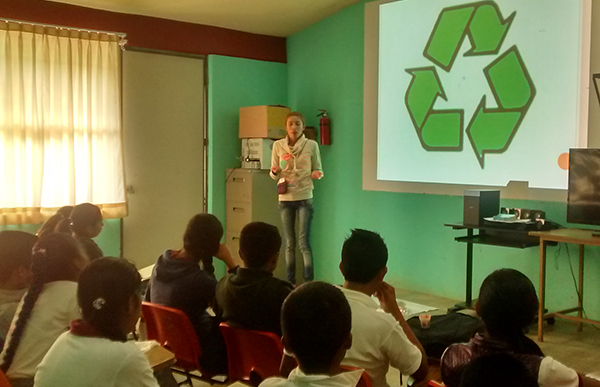Comprehensive Municipal Solid Waste Management Program in Oaxaca’s Southern Sierra
Organization: Género y Flor de Maíz, A.C.
Location:
Communities of San Francisco Coatlán and Santa María Coatlán in the municipality of San Pablo Coatlán, as well as the municipalities of San Jerónimo Coatlán, Santa Catarina Cuixtla and San Miguel Coatlán, all in the Miahuatlán district in the State of Oaxaca.
Country: Mexico

Background
No municipality in Oaxaca’s southern sierra region has a solid waste management program. Most farm residents burn their waste (plastics and PET [polyethylene terephthalate] included). Municipalities have precarious waste collection systems and deposit trash without any kind of management in municipal dumps. Only the municipal seats collect waste, every 15 days, although they do not have temporary storage sites or collection centers, and the transportation system is deficient. A highly negative environmental impact is seen in the communities, as the disposal sites or open-air dumps—mostly ravines—leak leachates and other waste into the subsoil. The negative impact includes the contamination of water resources, the air, the soil and the landscape. The region also lacks strategies to reduce the generation of municipal waste.
The project will help build capacities in the comprehensive management and handling of municipal solid waste, to prevent and mitigate the trash issue, improve the area’s environmental quality and create a environmental education program for the community.
Goals
- To give three communities environmentally sound infrastructure for waste collection, pickup, reuse, recycling and treatment, in order to maximize its valorization.
- To generate a children’s educational program aimed at reducing trash generation and decreasing the quantity of waste intended for final disposal, through reuse, recycling, and sound management.
- To assist communities and municipal authorities in the implementation of a comprehensive management and handling program for solid, special and hazardous waste, as well as the establishment of two collection centers.
Main activities
- To install a municipal solid waste management center (“collection centers”) in each of three communities, enabling the collection, pickup, reuse, recycling and treatment of waste generated.
- To hold cleaning days in the communities to sensitize and train the population on waste management and to inform residents of the creation and operation of collection centers.
- To provide workers who pick up municipal solid waste with the necessary equipment to perform their duties and with adequate health protection.
- To implement a formal environmental education program in all participating communities and municipalities for children and youth, from preschool and primary school to middle and high school, to heighten their awareness and train them on the management of municipal solid waste.
- To create an informal environmental education program geared toward residents of the participating communities and municipalities, to heighten their awareness and train them on the management of municipal solid waste.
- To work with municipal and community authorities to organization, create and manage—in the framework of a regional waste management strategy—a participative work program enabling the comprehensive management of municipal solid waste at collection centers.
Results
- Three collection centers built to collect, reuse, recycle and adequately treat municipal solid waste.
- Municipal workers equipped and trained, with adequate protection, to collect municipal solid waste.
- Communities and local populations aware of the environmental issues posed by solid waste, as well as the fundamental importance of sound management and disposal.
- Children, adolescents and youth with a high level of sensitivity regarding the comprehensive management of municipal solid waste.
- Environmental education program created and applied in participating communities, with educational materials appropriate for each grade and the cultural characteristics of the region.
- Municipal solid waste management plans at schools in the participating communities.
- Municipal authorities with a comprehensive solid waste management and handling plan within the municipal jurisdiction, associated with a regional agreement.